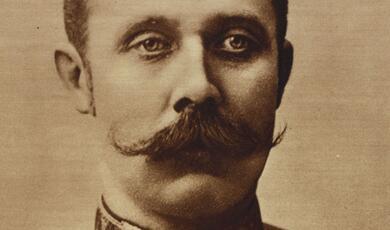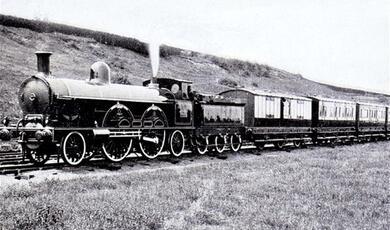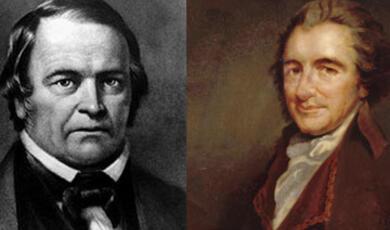The Dictionary Garret - Anatomy of a Room
Share
- Details
- Text
- Audio
- Downloads
- Extra Reading
The garret at 17 Gough Square was the nerve centre of the house during Samuel Johnson's residence, and here the greatest work of reference of the 18th century took shape. Johnson's Dictionary (1755) gives the room its historic resonance, but what became of the room once its famous occupant had left?
Download Text
THE DICTIONARY GARRET: ANATOMY OF A ROOM
Natasha McEnroe
Dr Johnson’s House is rather tucked out of the way, but I like to think that that adds to its charm. I know for many people it does represent a small corner of 18th Century London, particularly if you turn away from the main drag and the commerce of Fleet Street. It’s possible to just walk into the house, sit down, read, or even just sit and imagine the great Doctor and his friends working and living their lives two and a half centuries ago.
The house itself was built in 1700 and has been open as a museum since 1913. It is the last of Dr Johnson’s 17 London residences to survive, and it’s here that he wrote the great dictionary of the English language, published in 1755. As well as being an essential place of course for admirers of Johnson to visit, it’s a very fine 18th Century townhouse in its own right.
I’m going to be focusing on the history of the house, and specifically on the history of the best known room in the house, the Garret which Dr Johnston used as his work room, and as we’re looking at the room throughout the centuries, we’re going to be meeting a cast of characters as disparate as Thomas Carlyle to Sherlock Holmes.
Well, we may make a pilgrimage to the Garret today and sit and remember Dr Johnston. I find it fascinating to think that for the last 200 years people have been doing that exact same thing. I’d like to begin this talk by reading an extract from a book written in 1921. It’s a book about London, a fictionalised guidebook, and the character is describing his visit to the Dictionary Garret:
“We climbed the winding staircase and stood in the Garret where the dictionary had been written, a long low-ceiled room with small curtained windows, one end of which was chill with the approach of dusk, whilst the other was warmed by the slant beams of a red sun shining amongst the crowding chimneypots and telephone wires. I pictured on such an afternoon Johnson’s six amanuenses busy at their part in the great work, and wondered whether they knocked off at dusk.”
The Garret itself encompasses the entire top floor of 17 Gough Square. Although this is the only room that really suffered from bomb damage in World War II, we know from 19th and early 20th Century drawings and illustrations of this room that the layout is very similar to the way that it would have been in previous centuries. The room, as befits the top floor of the house, is very plain, with no decorative mouldings or carvings.
As a general rule in Georgian houses, the primary floor is of course on the first floor. The second floor might be for less important rooms, perhaps bedrooms, and the top floor is inevitably the province of servants and children, so you’d have all of the nurseries and the servants’ quarters up underneath the roof. The internal decorations of the house would reflect that: you would have the very elaborate carvings and so forth on the first floor and it gets plainer as you go up, so by the time you reach the top floor, you often just have skirting boards that are literally plain boards and perhaps no cornicing at all. So you would have the interior decoration reflecting the social usage of each of the rooms and each of the areas of the house.
We have a photo of the room taken before World War II that was probably taken again in the 1920s. It seems that the top floor at 17 Gough Square had no room dividers in the 18th Century and was what we would call open plan, so it takes up a large amount of space. It might possibly have been the large amount of space that attracted Johnson to hiring out the house in the first place. He did only ever rent it. He had already been commissioned to write the dictionary when he moved to Gough Square in the late 1740s, and he knew of course that he needed a large space as a work room. In addition to the reference books that he needed, and the tables, desks and so forth, he employed six or so assistants, his amanuenses as he called them, to assist him in his work.
Now, this large space at the top of Dr Johnson’s house does cause us some problems in terms of the initial intended usage of the house. As we’ve just described, the space under the eaves of a house is inevitably the servants’ and the children’s area. It’s often too hot in the summer and too cold in winter, so you wouldn’t put anybody very important up there. But this great space has an open stairwell to the west of the room, and so it could never have been intended as a sleeping space, and the architect’s intention continues to be a mystery. In a poorer area, such as Spitalfields, quite often the top floor windows are very tall with big skylights and are actually designed to be used as work rooms for the silk weavers, and you can see some of these extended windows in houses still extant in that area, particularly around about Liverpool Street. But while this might have been the case in Georgian Spitalfields, a fine merchant’s house in the City just simply wouldn’t deliberately have a large workspace at the top of the house, so we simply don’t know today.
Georgian houses often had their roofs hidden from view as much as possible to ensure a nice square effect of the frontage of the house, and one way that this has been achieved at Gough Square, as in so many different houses, is to have the roof as an M-shape, and you can just see the two points at the very top over the parapet, so that you don’t have one tall point, you’ve just got the two smaller ones because it’s easier for them to be concealed and you have a nice big square frontage. This can cause some housekeeping problems as of course it does leave you with three deep valleys that can fill up with leaves and other odds and ends.
The sloping walls to the north and the south side of the room have dormer windows set in it, dormer of course coming from the French “dorme”, to sleep, and were traditionally rooms towards the top of the house. The east wall is the only stretch of a long flat wall in the room, and it has two windows in it. It does seem to have been three in Johnson’s day, and 18th Century accounts say that, but it seems that the central one was subsequently blocked up and is still to this day.
The front windows to the house are all classic Georgian style of double-hung sashes, and in the Garret and the second floor, the windows have the six over six panes of glass size, whereas the lower rooms have the larger nine over nine. Sadly, none of the windows dates from the 18th Century – none is original to Johnson’s day at the moment.
The last architectural feature of the room that I’d like to mention is the wooden balustrade that’s made of turned pine. Now, similarly to the rest of the house, the design details of the staircase, which is completely original, all the way from the basement up to the Garret five floors above, the design changes and becomes simpler as you get near the top. So on the first floor, you have lovely finely turned balusters, but by the time you can get up to the top, they’re done with far less care, and you can see that quite clearly when you look at the originals. They’re far bigger and they’re actually alternated with just single poles of square cut wood, so they haven’t made any effort to make that look pretty at all.
The house is currently painted in colours that would have been absolutely ubiquitous in mid-18th Century London: sand, stones and brown colours. You would never have any unpainted wood in a Georgian house, with the possible exception of if you had a very finely carved staircase perhaps in a country house, and then you might have left that as bare wood, but you would have almost always have had doors and stair rails painted.
There is a modern illustration by E. H. Shepard, the illustrator of Winnie the Pooh, who did a version of Boswell, illustrating famous scenes from Boswell in the 1930s, and it’s quite a nice line drawing that comes from this particular edition. It shows Johnson and his amanuenses beavering away up in the Garret.
The description of the Garret that comes to the minds of most Johnsonians is the famous quote from Boswell’s life: “He had an upper room fitted up like a counting house for the purpose, in which he gave the copyists their several tasks.” Arguably, however, the Garret wouldn’t so much have resembled a counting house as an assembly line at the time. We know from various descriptions that there were tall desks for the copyists to work on, and bookcases. Bookcases must have taken up the flat window east wall, as the sloping walls do come down almost to the floor and, as we mentioned, the fireplace and the stairwell takes up the west wall.
Following the publication of the dictionary, Johnson seems to have turned the room into more of a private study or a sort of a library for himself when it was no longer needed as a work room. He was, by this stage, a widower, and he began to fill the house with various people that needed his financial support, possibly as a way of staving off loneliness following his wife’s death. But despite having a fuller house the Garret would really have never have made a bedroom. The open stairwell would simply make that impossible in its open plan setup.
So although ideal as a work room, it is less handy as a private space of any type. One reason that the grieving Johnson then gave for it to be used in that way was that, “It was in this room only I never saw Mrs Johnson.” So he wouldn’t be reminded of his wife.
It was when Johnson was using the room as a private study that he received a visit from his friend, the famous musicologist, Dr Bernie. Dr Bernie was very famous in his time. To us today, he’s probably better known as the father of the novelist Fannie Bernie. Boswell describes this visit from Bernie, which I’d like to read to you.
“After dinner, Mr Johnson proposed to Mr Bernie to go up with him into his Garret, in which, being accepted, he found about five or six Greek folios, a deal writing desk, and a chair and a half. Johnson, giving to his guest the entire seat, totted himself on one with only three legs and one arm.”
By the mid-1750s, that is in the time between his wife’s death in 1752 and Johnson leaving the house in round about 1758, we can see from this description and from other accounts that the house was becoming increasingly dirty and dingy, and also, as we can tell, rather badly furnished.
After Johnston left the house, we don’t know anything at all about its usage for quite some time. Some correspondence of Harry Gough, the landlord, after whom of course Gough Square was named, suggests that the house was really in a state of poor repair, and it wasn’t just that it needed a good clean. It’s quite possible that following Johnston’s residence there that it was never again used as a private residence. It’s quite useful from our point of view because I think that whereas if it’s a private residence, people are more likely to make alterations, whereas if it’s an office space or a work space, they are less likely to. If a door handle actually opens the door, they’re not necessarily going to change it. So for example, at Johnston’s house, we do have the original door handles throughout.
The next factual account we have of the house is a description of a visit by the famous author and philosopher, Thomas Carlyle, in 1832, so that’s of course over 70 years after Johnson left. Carlyle reports: “It is at present a place of business, but the tenants make no difficulty about your examination of it, and when you enquire for the well known Garret, you are at once invited to inspect it.”
Carlyle compares emerging from the stairs into the Garret “as in a hayloft”. Interestingly, he also states that the room has three windows. He describes the room quite carefully, “the room has three windows on the east wall”. So this means that one theory that the middle window was blocked up as a result of the hated window tax which was – there were teo – 1766 and 1784 I believe, but much earlier, so again it does remain a mystery as to why this central window was blocked up.
The landlord of the house, which I think is hilarious, completely offended Carlyle by suggesting that Carlyle might be interested in hiring out one of the rooms, presumably to share with a lady friend. Carlyle then goes away and writes in his diary, “The landlord, dog of a fellow, began to hint that all these rooms were to be let as lodgings!”
Later, 17 Gough Square appears to have been used as a slightly more respectable, or at least a more formal, guesthouse. The visitors’ book at Dr Johnson’s house has the signature in 1921, so after it had been turned into a museum, of a Frederick Partington of Washington, who describes how he slept in the Garret for a month as a young boy some 50 years previously in 1873. The landlord at the time apparently had said to him, “You’re a young lad and you can climb, so I shall give you the top room,” adding, “but when you get older, you’ll be proud to say that you slept in the very room where Dr Samuel Johnson compiled his great dictionary.” Partington remembers only two rooms up in the Garret, and he said that he had the southern end with the fireplace, and note that because I’ll be coming back to that later. It is possible that he was misremembering the number of rooms on the top floor at that time, as Carlyle and other accounts say that there were three rooms. Now, the explanation for this of course is quite simple: to use the house as a guesthouse or as a hotel, the owners had decided to divide up the Garret. Early pictures show it as open plan and of course unsuitable as bedroom space, so they literally just put in, as we would today, modern partitions so you could hire them out as extra bedrooms, although possibly, as I said, you might have to rent them out only to the young and fit people who wouldn’t mind all the stairs up to the top of the house.
After being used as a guesthouse, the house was used as a printers and a publishers called Waller & Baines, but by the beginning of the 20th Century, the house had fallen into disrepair, and of course as the space nearest the roof, the Garret became the room that took the most punishment of all.
I discovered a potograph in the archives only recently, and we did have to diddle around with it a bit to try and lower the glare, but you can see the dormer window that’s set in the wall, and one of the partitions, and there’s a great big hole in it, and it shows the Garret with part of the room dividers up. It’s quite hard to make out, even for me that knows the house quite well. But it really does give the impression of quite how grotty it would have been at this stage. Somebody had stuck loads and loads of little postcards and prints and advertisements of things up on the walls, which a Victorian print expert could doubtless identify for us. Although I had read for years that the house was nearly derelict, I somehow don’t think I really took it seriously. I had felt that it would be sort of BBC drama derelict, you know, and not like you would see a modern house that perhaps had been squatted in today. But that photo shows quite how hideous it actually would have been.
Luckily for the house, by April 1911, its fortunes took a huge turn for the better, as it caught the eye of Cecil Harmsworth, who was a Liberal Member of Parliament who was working nearby at the time. He basically thought it was an absolute crime that this really important building was being allowed to fall into this awful state of disrepair. His ambition was to restore it to the condition that it would have been in Johnston’s time. He described it, and again I have read this account many a time but just hadn’t quite I suppose quite taken it on board. Harmsworth himself says of the house at this time: “It is doubtful whether in the whole of London there existed a more forlorn and dilapidated tenement.” Of the Garret in particular, Harmsworth notes: “The roof leaks disastrously, and the plaster had fallen off in large patches from the ceiling and walls.”
As part of the decision making process of this restoration, it was decided that nothing new should be brought into the house, or as little as possible that was new, and nothing old should be taken out of it. So the 19th Century room partitions of the Garret were removed, and they discovered that the wood that had been used to section off the room had literally been taken down – was part of the panelling from other rooms, so it’s the equivalent of me taking a hacksaw to this nice bit of panelling here in Barnard’s Inn Hall and sticking it over in a different room. So the fact that they hadn’t chucked any wood out at all meant that they were literally left with a pile of wood: they had to use huge amounts of detective work, but they discovered, and you can imagine their delight, that once they got down to it, that it actually did slot back in again very neatly, and that practically all of the original wood was in fact in place.
The windows, however, had been tinkered with and it was decided at that time that they were modern and unattractive and unsuitable, so all of the glazing bars and the glass were replaced.
In the rooms on the lower floors, the panelling, whether it was still in its original situation or not, was just covered with layer upon layer of wallpaper and other sorts of paper that had just hardened over the years. So they had to chip away at this and discover the lovely original wood underneath.
They also discovered, incidentally, quite a lot of cupboards that had been papered over and sealed up, and which now really add to the charm of the house, but very sadly, they didn’t find any lurking manuscripts walled up, which I always think is rather unfortunate.
The Garret, incidentally, is the only room in the house that doesn’t have any panelling. It’s purely plaster.
In addition to the work on the house itself at this stage, a small lodge was built next to museum, which is where I now live, and was designed for the curator of the time to live in. This shows great foresight of the trustees because with any historic house, you do need somebody living in. You can have the flash floods, fire, and so on. Even with the best security system in the world, nothing really beats having somebody actually living there. You’ll be aware from visiting other historic houses that nearly always perhaps the top floor or some level is closed off for the custodian to live in. So it showed great foresight I think that they designed and built this small lodge so it means that we can have all of Johnson’s house open to the public and still have the benefits of somebody actually living in but as part of the next door building.
The first curator in 1913 was called Mrs Dyble, and she was a renowned Johnson scholar. She ran the house for many years, and in the latter years, she was working in tandem with her daughter, Mrs Rowell. Mrs Dyble and Mrs Rowell, who were both widows, lived with another inhabitant of the curator’s lodge, Mrs Roll’s small daughter Betty, and she spent her childhood using the museum as a sort of extended play area which, I’m sorry to say, my own children also do today.
Mrs Rowell carried on running the house up until the Sixties. Following her death a third curator, who was unrelated to the other two, came along, a Miss Elliot, and she ran the house for many years as well. People love Dr Johnson’s house so much they do tend to stay there until the bitter end! Following her death, Betty, the granddaughter of the first curator, who by then was of course an elderly woman herself, returned to the house and to the curator’s cottage to act as the fourth curator. You can imagine she had marvellous stories of the house and of her memories of particularly the earlier years of the museum.
I’m the fifth curator, I hasten to add unrelated to anybody of any significance, but the family of Mrs Dyble and Mrs Rowell and Betty are still in touch with the house and they’re very loyal and attend our various events.
Of course Mrs Dyble and Mrs Rowell were to see Dr Johnston’s house through two World Wars. Mrs Rowell relates a story of how her mother had drawn comfort from the timeless atmosphere of the Garret during the raids of World War I. According to Mrs Rowell, her mother “scorned to take cover, and instead mounted to the attic and read Boswell’s life until the “all clear” was sounded”! Happily, both the house and the redoubtable Mrs Dyble remained unhurt during the zeppelin raids.
We must remember at this time that Fleet Street and its environs were of course dominated by the noise of the chief industry of Fleet Street. A visitor to Dr Johnston’s house of 1921 describes how he “wandered everywhere unmolested from room to room, finding everywhere a strange silence set in the monotonous hum and clack of the printing presses outside, a sound which fills the neighbouring courts and alleys with a ceaseless thump, thump, as of the labouring heart of this backwater of Fleet Street.”
By 1940, 20 years after this observation, the noises outside Dr Johnson’s house were of course to become far more sinister than the friendly clatter of the printing presses as the enemy raids on London commenced. The Garret caught fire on the night of the 29th of December 1940, that terrible night which, as you know, destroyed so much of the City of London, and then again, less than a month later, on the 18th of January 1941, and again was damaged by a flying bomb on the 18 th of July 1944. We have an illustration by Feliks Topolski showing the firemen tackling the 1944 fire.
A healine from the Evening Standard on the 6 th of January 1941 reads “ Gough Square ghosts must be weeping in Johnston’s Garret”.
Mrs Rowell said: “If spotters had been stationed on the roofs of Gough Square on Sunday night, Dr Johnston’s house would not have been seriously damaged, nor the nearby buildings gutted.” This is a quote from Mrs Rowell. She may not have realised of course that on the night in question the decision had come from on high to concentrate all manpower on protecting St Paul’s Cathedral, which was of course such a powerful icon. So it’s quite possible that she was correct in feeling neglected: although perhaps a great symbol of London, Dr Johnson’s house I think has to stand second to St Paul’s Cathedral, certainly in height.
The journalist in the piece continues: “There was no roof and only parts of two walls, and the rest was wreckage.” Mrs Rowell explained that the square was unwatched that night with only the three women there on sight duty. They were actually alerted to the fire by a passing stranger, and he helped them put out several of the fires and then disappeared. The roof was covered over with a temporary roof of corrugated iron which, as is often the way of temporary things, was to remain in place for several years, and this was to be the only thing that covered the Garret for some time.
The continuing raids, sadly, proved to be too much for the now elderly Mrs Dyble, and she died in the last years of the war. On returning from her funeral, Mrs Rowell and her young daughter Betty were alarmed to see two incendiary bombs on the temporary roofs, and they once more raced to the Dictionary Garret. “We rushed up the stairway and, packing them round with sandbags we had stored in the Garret, we then wet the sand with a fine spray from a stirrup pump which was used in the large water tank the firemen had fixed for us.”
The friendly firemen were granted permission to use Dr Johnson’s house as a rest centre for the rest of the war. Mrs Rowell would pour out tea to a group of admiring chaps – again, uncannily similar to my everyday activities! One of the officers was to marry Mrs Rowell’s younger daughter, Betty, and it’s their son and also his sons that still remain in close contact with the house.
The Manchester Guardian reported on the 2nd of November 1946 that a piece of the temporary roof, the corrugated iron roof, had been blown off and had to be replaced with a tarpaulin.
Mrs Rowell, who’s clearly good for a quote, said in the Guardian: “It maddens me, after saving the Johnson relics from the flames, to see the house left derelict.” Really, you know, she must have been a tough woman. She literally packed up the ceramics – Boswell’s mugs, the tea set - in a suitcase and took them to an air raid shelter every time that the sirens went.
Restoration work was finally to commence in the late 1940s and was financed by the war damage insurance and also a generous grant from the Pilgrim Trust. Fortunately, the balustrade was left untouched, so we still have the original.
Although you can tell from early photographs and drawings that the roof beams originally were left uncovered, the decision was made to have them on view. They’re virtually charcoal, so they’ve got practically no load bearing use at all, and they’re braced on to steel girders. They’re there partly as a sort of war memorial.
An early 20th Century watercolour shows the view from the Garret. Of course this is how it would have looked to Dr Johnson, and in fact to anybody up until the Blitz, so it’s a reminder of quite how dramatic the Blitz was in this particular area. Of course the view from the Square now is dominated by Goldman Sachs, looming over us.
It’s also in the 1940s that the Dictionary Garret hit the silver screen in the film Dressed to Kill, one of a series of Sherlock Holmes films starring Basil Rathbone. Mr Holmes and Dr Watson discover a clue in Dr Johnson’s house, and an important scene is played out in the Garret. We’ve got a DVD of it in the library of Dr Johnson’s house. Somebody kindly donated it to us. The scenes shot in the lower rooms are clearly nothing like the real building, but the scenes in the Garret I had to actually sit and watch two or three times before working out that actually there’s a few key differences and this wasn’t actually the original room. It was just a clever set. But I later realised, feeling rather foolish, that I could have worked that out quite easily by just checking the date of the film. It had in fact been filmed in 1946, when of course there wasn’t actually a roof to the Garret! But I think it’s fascinating that the producers went to such efforts to produce a realistic set. I know the house extremely well, and I had to look very carefully, and I think it’s quite a good reminder of the iconic nature of the room.
The next really major part of the restoration carried out in the Dictionary Garret took place during 2002. The structure of the house was giving cause for concern and it was clear that work was needed. This made a good opportunity for us to again look at the Dictionary Garret and especially at the floors. The 18th Century floorboards had been burnt out and had been replaced by some narrow, quite poor quality boards, and they’d also been covered with some deeply unattractive wall-to-wall beige carpet that was another one of those temporary measures that was there for at least a decade. It was decided that while the structural work was taking place it would be sensible to replace these rather narrow, modern boards with much wider ones that had been cut from 19th Century very wide beams, and these new boards were brought into the Garret and then had to hang around for ages so they could get used to the house and settle down a bit before they were fixed down.
Incidentally, I’ve always got an eye to a fund raising opportunity, and as part of the structural work, they gouged out a small central section of the main supporting beams, so when this wood was bagged up to be chucked out, I took a bag of it to one side. It is of course part of the original 18th Century building and I’ve been doing quite a nice sideline in selling off bits of it to keen Johnsonians with a little certificate, so if anyone’s interested, do just ask me afterwards!
There is a second chimney. We weren’t aware of its existence until the floors came up. It’s on the same wall as the existing chimney, and again, we can hope, for Johnson and his amanuenses’ sake, that they were both in place at the time that the great work was being carried out. If you remember, Frederick Partington in the late 19th Century said that he was in the room with the fireplace, so perhaps it had already gone by then, we simply don’t know.
The Garret today is still as much in use as it would have been in Dr Johnson’s day. We use it to host temporary exhibitions. Also, we have school groups and they tend to use this room most as the largest room, and we often have plays and lectures there. Perhaps most importantly, it is used by admirers of Johnson who appreciate a time just to sit quietly and to think of the great man and his great work.
Perhaps next time you come to visit Dr Johnson’s house you might like to just sit down quietly and remember not only Dr Johnson but also the very rich and varied cast of characters that we’ve been talking about this evening who all, together, make up the very rich and varied history of the Dictionary Garret.
© Natasha McEnroe, Gresham College, 8 December 2005
This event was on Thu, 08 Dec 2005
Support Gresham
Gresham College has offered an outstanding education to the public free of charge for over 400 years. Today, Gresham College plays an important role in fostering a love of learning and a greater understanding of ourselves and the world around us. Your donation will help to widen our reach and to broaden our audience, allowing more people to benefit from a high-quality education from some of the brightest minds.


 Login
Login







